Are we on the verge of a global pandemic? (UPDATED)
In early January 2020, an outbreak of a previously unknown virus, centered around an animal market in Wuhan, China, began rapidly spreading across the continent, causing high fever, pneumonia-like symptoms and dozens of deaths among the hundreds of people infected. “2019-nCoV”, as it is now known, is following the increasingly recurring scenario of an emerging infectious disease, one that is spelled out clearly in the Natural History Museum’s exhibition “Outbreak: Epidemics in a Connected World,” on view through fall 2021.
The Torch spoke with Sabrina Sholts, curator of “Outbreak,” to learn how a new virus can become a worldwide pandemic.
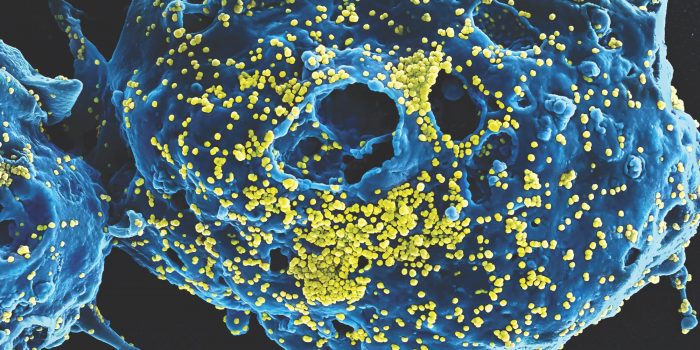
What can you tell us about this new outbreak?
What we know is that it is similar to SARS (a virus that caused Severe Acute Respiratory Syndrome and spread worldwide in 2003) in that it’s a human transmissible coronavirus that causes pneumonia-like illness. We don’t yet know the exact way it’s spreading or how easily, but human coronaviruses are most commonly spread via air through coughing and sneezing as well as via touching. This is a very efficient way for a disease to spread, unlike via body fluids, such as HIV, which is much more difficult to transmit.
As is often the case in the early stages of these outbreaks, there is a lot we need to learn about how it spreads, precisely where it came from, how dangerous it is, and what range of symptoms infected people show. Information like this can help piece together the risks of infection and how its spread can be controlled.
SARS originated in bats, as a lot of viruses do. We don’t yet know what the reservoir of this new virus is. Some of the earliest human cases this outbreak were linked to an animal market in Wuhan, where a spillover [cross-species transmission] event could have occurred. Many species of animals were being sold there, some of which may serve as intermediate hosts and even amplifiers of a pathogen like this.
With SARS, civets were among the market animals that tested positive for the virus. But there are many other species that have the potential to be infected by such a virus.
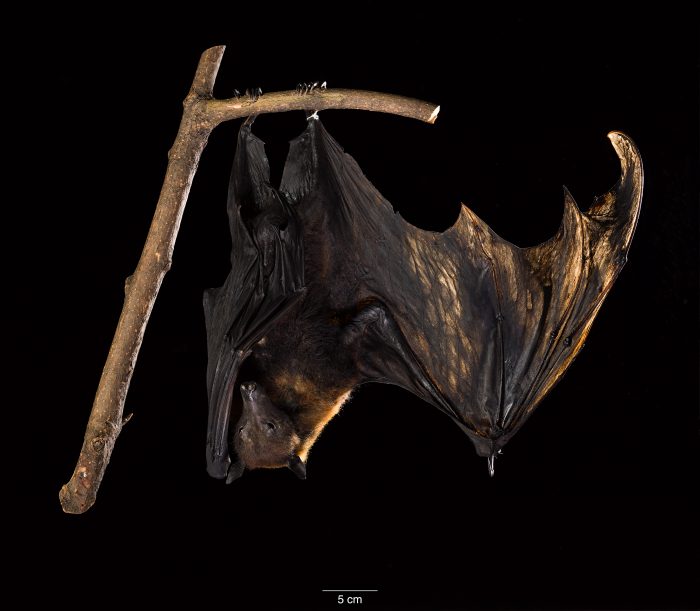
Some animal species carry viruses that can also infect humans. These animals are reservoir hosts. Bats, rodents and non-human primates are the most common reservoirs in nature. This specimen of a wild fruit bat is on display in the new exhibition, “Outbreak: Epidemics in a Connected World,” at the Smithsonian’s National Museum of Natural History through 2021. (Photo by James Di Loreto, Lucia RM Martino and Fred Cochard / Smithsonian)
What do you mean by reservoir?
A reservoir is the natural host of the kind of zoonotic [animal origin] pathogen that can spread to humans. But the reservoir host is not sickened by the virus. We can’t really call the microbe a pathogen if the host doesn’t show any adverse effects – it’s more like an evolutionary partner. The reservoir animal is adapted to carry and live with this virus while potentially spreading it to other species that aren’t, in which it then can cause sickness or death.
Are the early stages of an outbreak the most critical?
Yes, it is a time to respond appropriately and quickly. With this new coronavirus there has been much quicker action than was seen in 2002-3 with SARS in terms of the scientific information coming out.
The genetic sequence for this virus has already been shared, and scientists have studied it and developed ways to test for it. Researchers can confirm that this is a new virus and compare it to other known human and non-human coronaviruses. This information will help determine where it came from and develop the best tools to fight it.
We are in a much better place in that respect than we were at this same early stage with SARS, but there is a lot more that still needs to be known. For example, modeling is now being done regarding the possible extent of its spread. Where carriers have traveled, what the potential risks are outside China—airports and other points of entry where security procedures may need to be put in place.
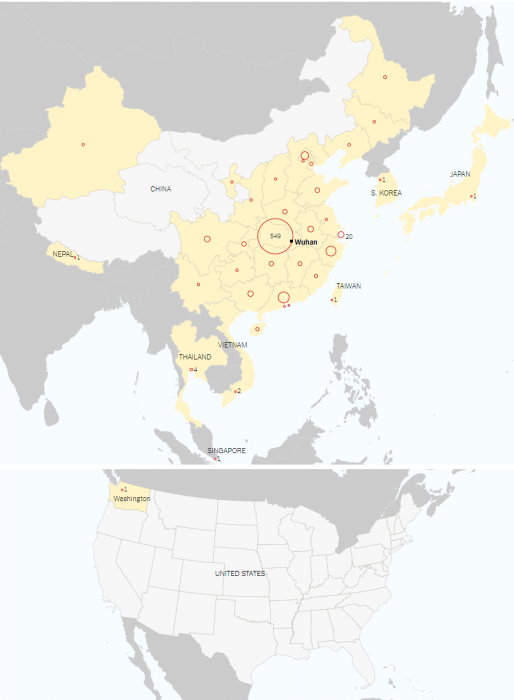
Confirmed cases of the Wuhan Corona virus as of 8:00 p.m., Jan. 24, local time. Graphic created by The New York Times data provided by the National health Commission of the People’s Republic of China and local governments. https://www.nytimes.com/interactive/2020/01/21/world/asia/china-coronavirus-maps.html
The fact that it seems to have originated in an open animal market fits with what visitors learn in your exhibition “Outbreak.”
Absolutely, and it fits with the main message we are trying to help the public understand here at NMNH with this exhibit: We share so many of these pathogens—that emerge, grab the headlines and frighten people—with other animals and we need to pay attention to that interface: our ecological relationships, our interactions with wildlife and livestock and other animals that can potentially expose us to these threats. The main message of “Outbreak” is “One Health,” that our health is connected to the health of animals and the environment.
The most common reservoir animals for zoonotic viruses are bats, non-human primates and rodents. A SARS-like coronavirus was found in horseshoe bats and points to bats as its zoonotic origin. Again, we don’t know yet, but I would think that, as with Ebola, influenza, and other diseases that we feature in “Outbreak”, a wild species is the original source of this new virus. But it doesn’t have to be, and often isn’t, a direct transmission –a bat can infect a pig, for example, which in turn can infect a human, such as we’ve seen with Nipah virus in Malaysia.
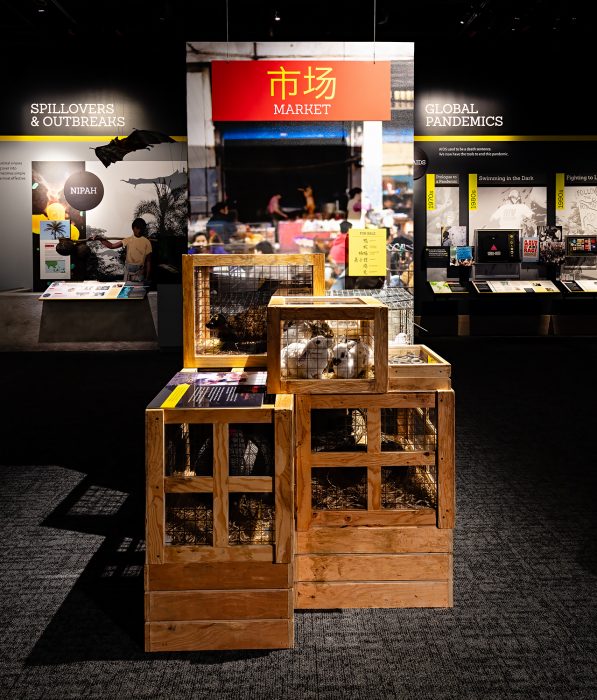
Animal health is linked to human health. Most viruses that infect humans are zoonotic—they originated in other animals. Influenza, Ebola, Zika, HIV and SARS are just a few of the over 800 known zoonotic viruses that cause human diseases. From industrial farms to live-animal markets, animals kept in crowded environments can easily spread influenza and other viruses. A crowded market scene featuring taxidermy specimens and models of wild animals provides a look at how spillover opportunities increase in scale and scope in an urban setting. In some countries, animals of different species are caged stacked or close together in live markets. Many of these animals never ordinarily meet in the wild. This creates opportunities for viruses to jump from one species to another. This market scene is on display in the new exhibition, “Outbreak: Epidemics in a Connected World,” at the Smithsonian’s National Museum of Natural History through 2021. (Photo by James Di Loreto, Lucia RM Martin, Fred Cochard / Smithsonian)
It seems that with each modern outbreak humans are getting better at dealing with them. True or not?
I think in some ways we are. We have tools that expand our ways to communicate, our ways to conduct surveillance to keep track of potential risks. There is growing support for the interdisciplinary and international cooperation that an outbreak requires.
That doesn’t mean we can’t be surprised. So many factors affect our ability to deal with pandemic, including funding, support and the value we place on being prepared. That’s one thing we emphasize in “Outbreak,” preparing and preventing as opposed to being reactionary. Responding once an outbreak has begun to spread is far more costly and often less effective than trying to stay ahead and stop an outbreak before it becomes an international epidemic or pandemic.

During World War I, more people died from the influenza pandemic (estimated 50 million–100 million) than from the war (estimated 17 million). Over half of the deaths from the pandemic virus were adults between the ages of 20 and 40, rather than the young children and elderly who typically die from the flu. Hospitals were quickly overwhelmed by the number of people sick from the flu and the secondary pneumonia cases that followed. Temporary, often overcrowded, infirmaries were created in auditoriums and public buildings to care for the sick. This photo of flu victims during World War I is on display in the new exhibition, “Outbreak: Epidemics in a Connected World,” at the Smithsonian’s National Museum of Natural History through 2021. (Photo courtesy U.S. National Library of Medicine)
With the corona virus in the news are you wary about working in a museum that daily welcomes visitors from all over the world?
I don’t feel that I am at any greater risk here in this museum, which is a relatively open space, than a confined and densely packed one like a subway or a train station. There are far worse conditions that would be conducive to the spread of disease than this museum. So no, that is not something that I think about as an occupational hazard!
In terms of being a global citizen, I have come to a deeper understanding of some risks. Since curating this exhibit. I’ve changed some behaviors, for example. I stay home now when I’m sick or feeling sick, which I never did before, when my view of “responsibility” was different. Today, I am far more sensitive and cognizant of the potential for different types of transmission. Those small things are good practice any time and wherever you work.
We have an entire wall in “Outbreak” emphasizing what people can do both individually and as communities and societies, to reduce exposure to disease, including simple things such as hand washing, not touching dead animals and getting vaccinated when possible.
If everyone was vegetarian would we have fewer outbreaks?
That’s a good question. Sometimes, the transmission of a virus can happen by direct contact with an infected animal by butchering, preparing and eating it, as we have seen in some outbreaks
However, the food system on which we are reliant, the industrialized agricultural system that characterizes so much of the world today, is definitely driving our pandemic risks because we are ecologically disrupting habitats where wild animals can get pushed out and come into contact with us as well as huge populations of livestock and poultry. Lessening the demand for animal protein is one thing we should be thinking about.
Anyone concerned about this new outbreak should come visit the exhibit at the Natural History Museum. There is a great deal of information about what you can do to reduce infectious disease risks for yourself and others.
UPDATE from Smithsonian Occupational Health
Feb. 11. Smithsonian Occupational Health is continuing to monitor the 2019-nCoV Coronavirus situation. Based on the continued outbreak in China, the Centers for Disease Control (CDC) and U.S. State Department recommend all travel to China be suspended at this time. Any travelers returning / arriving from China are required to be monitored and in some cases, quarantined, for up to 14 days. Each Unit Director or supervisor should ensure any staff returning from China are placed in the appropriate leave or telework status.
Sustained person to person transmission in the U.S. and Panama has not been observed. The general public is not considered at risk in the U.S. and Panama without prolonged contact with a confirmed 2091-nCoV case or traveled from China in the past 14 days.
Over 37,250 cases of Coronavirus infection have been confirmed worldwide, of these only 307 of these cases are outside of Mainland China. As of Monday, February 10, 2020, this includes 12 US cases. Those 12 cases are the result of monitoring 337 “persons under investigation”. Of those, 225 have been confirmed negative, 12 positive and 100 are pending. While some of these people under investigation are in states with Smithsonian operations, the risk to staff and visitors continues to be extremely low and the current public health screening and isolation methods are effective. Occupational Health will provide updates as guidance changes.
Please see the CDC website for up to date information regarding Coronavirus and use their fact sheets and public health messaging tools as needed. https://www.cdc.gov/coronavirus/index.html
FAQ’s for the Smithsonian Community
Do I have to worry about accepting objects from affected areas?
We know from past research on this family of Coronavirus that they do not survive long outside of the body. Shipped objects from affected areas are not considered to pose a health risk.
Will SI be able to continue to host scholars, students and visitors from affected areas?
As of January 31, 2020 the United States is not allowing travelers who have been in China in the 14 days prior to their arrival to enter the U.S. (excluded are American Citizens, permanent residents, and their immediate family members). Some travelers may be subject to quarantine requirements. These travel restrictions are situation dependent and could be extended or revoked at any time. Open communication and pre-planning are highly recommended if you are planning to host visitors or scholars with residence or recent travel history in China.
I have travel planned to China next month, will I be able to go?
Travel to China is suspended until further notice. Guidance will be updated as the situation changes worldwide. The scope of the impact on the people of China is larger than both MERS and SARS outbreaks and will likely take longer to resolve. If you feel that your travel to China is urgent please contact OIR-ITTF@si.edu for additional discussion. More specific information can be found within Department of State Travel notices, CDC Travel website, and Smithsonian Occupational Health Clinic at 202-633-9355.
Should we limit public access to museums and our research facilities?
Since there is not any evidence for Community Spread within the U.S. or Panama, there is no reason to limit access to any demographic group or the general public at this time. Do not assume that someone of Asian descent is more likely to have 2019-nCoV, and do not let baseless fear lead to discrimination or prejudice.
People are buying masks and wearing them, should I?
Unless you are caring for someone with the Coronavirus, the CDC does NOT recommend a mask of any type as a protective measure at this time. Surgical masks or unfitted respirators are appropriate if you are sick with respiratory symptoms (current circulating illness being colds and flu; not Coronavirus) to decrease risk of getting others sick- if you MUST come into work. It is recommended if you do have respiratory symptoms, stay home! Return to work when your doctor has indicated you are no longer infectious, your co-workers will appreciate not getting your cold or flu.
If I don’t wear a mask, what can I do?
REMEMBER TO TAKE EVERYDAY PREVENTIVE ACTIONS. These are always recommended to prevent the spread of respiratory viruses.
- Avoid close contact with sick people.
- While sick, limit contact with others as much as possible.
- Stay home if you are sick.
- Cover your nose and mouth when you cough or sneeze. Avoid touching your eyes, nose and mouth with unwashed hands; germs spread this way.
- Clean and disinfect surfaces and objects that may be contaminated with germs.
- Wash your hands often with soap and water for at least 20 seconds. If soap and water are not available, use an alcohol-based hand rub with at least 60% alcohol.
Please contact Occupational Health Services at 202-633-9355 if you have any questions.
Posted: 24 January 2020
-
Categories:
Education, Access & Outreach , Feature Stories , Natural History Museum , Science and Nature



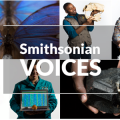




I agree that stopping the consumption of animals will help. I no longer eat meat for many years now because of their suffering . To me, this is nature fighting back. These Asian markets are terrible, those poor animals. Then you see them dumping live pigs in a mass grave burying them alive!!! So heartless. How ppl can do that is inhume.
Than there’s the over population of humans and destruction of forests, jungles and oceans. This world has gone to hell!!! People better start treating the animals and environment better. I have to say and it may seem cruel and insensitive but there’s too many people, we a locusts consuming everything on this planet and it is fighting back.
You write, “In early January 2020, an outbreak of a previously unknown virus … began rapidly spreading across the continent…”, however, it certainly emerged and was spreading well before 2020 began. After all it does have 2019 in its moniker. Also of interest, the ‘social pattern’ of an emerging virus was recognized by an AI platform in Canada in December and announced over a week before WHO or officials in China. https://www.wired.com/story/ai-epidemiologist-wuhan-public-health-warnings/
Thank you for the additional information, Chris.